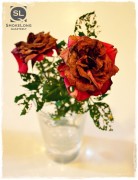My favorite of these may be “Crosshairs.” Sometimes you’re literal, characterizing an acorn next to the picture of an acorn. With the bullet image, you create a relevant but not literal narrative, inspired by the bullet instead of limited by it. My question is this: Why do you hate bullets?
I don’t hate all bullets. I don’t mind the ones in The Matrix that spiral through space in slow motion like subatomic particles in syrup so Neo can learn how to get out of their way. I also don’t mind bullet trains, although I would think twice before stepping onto one. But the bullet is only the delivery system. You know the feeling that comes when impersonal forces have you in their sights and the trigger was squeezed long ago. The payload is already on its way. It could be really good. It could be really bad. No way to know until it arrives.
The elephant in the (my) room: When I saw the first drawing, the aardvark, I thought it was an armadillo (it’s an aardvark—it says it right there in the caption). Where I live in Missouri, the highways are littered with armadillos. In your expertise, is there any such thing as a live armadillo?
Schrodinger’s armadillo is both alive and dead. Everyone in Missouri should be congratulated for being able to demonstrate this important principle of quantum mechanics.
The elephant in the (everybody’s) room: Where’d you get the idea to use these illustrations? Are they purely ekphrases? Tell us a bit how you found them, what inspired you to initiate this project.
The 1925 edition of Merriam Webster’s New International Dictionary of the English Language lies perpetually open on the book stand in our house. It is a formidable volume, made in an era when books were books, about five inches thick and full of beautiful engravings. This copy was originally owned by my grandfather Raymond Burton. I have always loved the illustrations. (I once used the hoopoe engraving in a New Year’s greeting to friends—Have a Hoopoe New Year!) What got me going: I had just finished writing a lot of long poems (most of which appear in my new collection, Your Enzymes Are Calling the Ancients, due out from Persea Books this fall), and I deeply needed to put on the brakes and work on something short for a change. So I started using the Webster’s images as writing prompts. I’d get home from work and write one and then have dinner. Then I’d do another one the next night. It became a daily practice, like piano or yoga. It was fun, and pretty soon I had a lot of them. I suppose you could call them ekphrastic, but they seem more like collaborations with the dictionary. Most of the time I bounced off not just the image but also the caption and the definition. I worked with the whole entry.
Once I realized the aardvark was an aardvark and not an armadillo, I thought this might be an abecedarian, maybe a bestiary, too (you know, because “aardvark” begins with “aa”). How did you choose which illustrations you’d write about? Plus, what’s the scope of this project? Are there more coming, maybe a chapbook or book?
Oh, yeah. There’s a book manuscript. It’s done. It’s called Aard-vark to Axolotl. There are 78 pieces in it, all from the A section of the dictionary. I thought for a second about moving on to do pieces from the B section, and then the C section, and then… I realized how long it would take to get to Z and decided doing that would be truly insane. As far as choosing which illustrations, I picked the ones I liked best and that would be challenging to respond to. I did over a hundred pieces total and pulled out my favorites for the manuscript.
Back to the illustrations: We’re told, as writers, that using illustrations is a crutch, that we’re supposed to be able to describe what we need with words. Clearly, though, your project wouldn’t be the same without the drawings. After Post-Modernism, when so many writers experiment in every which way, why doesn’t more serious fiction utilize image?
To answer this question, I would have to be a writer of serious fiction, or a serious writer of fiction, or at least serious in some way. I’m going to play the poet card and declare no qualifications on any of these fronts. I do know a little about short prose, since I edited a literary journal called ¶ A Magazine of Paragraphs for 20 years. My co-conspirator in this venture, Walker Rumble, always described what we were looking for as “short bursts of ordered sensibility.” People now call it flash. Maybe what I am doing could be called graphic flash. Is that serious? I just wanted to coax a 90-year-old dictionary to dance with me for a bit.



 The SmokeLong Grand Micro Contest (The Mikey) is now an annual competition celebrating and compensating the best micro fiction and nonfiction online.
The SmokeLong Grand Micro Contest (The Mikey) is now an annual competition celebrating and compensating the best micro fiction and nonfiction online.